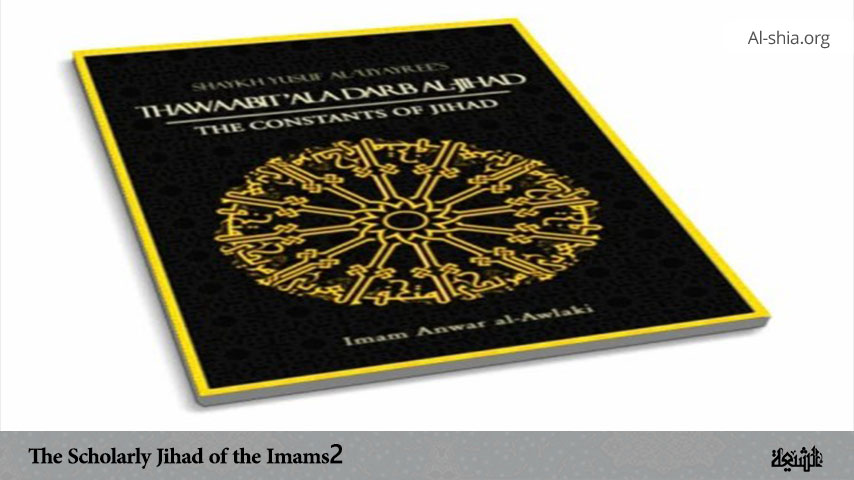In continuation of the discussions titled “The Scholarly Jihad of the Imams”, we shall focus on other relevant issues on the topic in this article.
Then came al-Mansur (13S158/754-775) whose only aim in life, it seems, was to kill every descendant of ‘Ali. The Shi’is in general, and the ‘Alawites in particular, were persecuted more brutally than they were during the reign of the Umayyads. He put even more hindrances in the way of the Imam. “He forbade the people to go to the Imam, and forbade the Imam to sit (outside) to receive the people, and put the utmost pressure on him. So much so that if a problem appeared in a Shi’ites life concerning, for example, marriage, divorce or some other matter, and he had no knowledge of the rule of the sharia about it, he could not reach the Imam, and, as a result, the man and the wife had to separate. (1)
After a long period, al-Mansur allowed the Imam to benefit the people with his divine knowledge, (2)but there were always spies to report his words and answers. Therefore, the Imam had to be cautious in his discourses. In short, the period of freedom had gone, so far as the Shi’is were concerned.
Anyhow, this period coincided with the movement of free thinking which had started in the Muslim world. Arabs came in contact with the older civilizations of Iran, Syria and Egypt, and became acquainted with Zoroastrian and Manichean beliefs and Greek philosophy. Some books had already been translated from Greek and other languages. Many scholars adopted strange beliefs and foreign ideas and spread them among the common people.
One finds a bewildering plethora of new sects mushrooming. Atheism was openly advocated even in the great mosque of the Ka’ba; the Murji’ites, by saying that faith is not affected by deeds, supported the tyrannies of the rulers; the “exaggerators” (ghulat) claimed divinity for this or that human being (even the Imam Ja’far as-Sadiq was believed to be God by Abul Khattab).
The Kharijites declared that all Muslims who were opposed to them were infidels; The Sufis adopted some ideas from Christian monks and Hindu ascetics and led people away from Islamic monotheism; the traditionalists flooded the Muslim world with forged traditions. In short, there was a deluge of anti-Islamic ideals and ideas which inundated true Islam. Amidst this all, these two Imams guided to the truth.
These Imams and their faithful disciples were the first to see this danger, and they were ready to fight it with their logical evidence. They defended their true faith, repulsed their enemies, and raised the standards of the shari’a. They launched an unremitting jihad (academic, of course) against the ghulat and showed them their true colours. They argued with the Muttazilites, the Murji’ites, and the Kharijites in public and proved the weakness of their standpoints. They exposed the Sufis and refuted their arguments. They corrected what was wrong in the theological ideas of many Muslim scholars, and showed them where they had gone wrong in jurisprudence. (3)
As we have explained above, the major part of this work was done by Imam Ja’ far as-Sadiq. As a result of his untiring defence of Islam, the Muslim world came to see in him the only hope for the salvation of Islam. Eyes turned towards him, thinkers accepted the Imam as their “great-teacher”; people used to come into his presence with pen and paper ready, and his words were recorded on the spot.
Thousands of such notebooks were filled, and the words of the Imam Ja’far as-Sadiq attained the same prestige as those of the Messenger of God. Not only the Shi’is, Sunnis, Mu’tazilites and atheists but also the Hindus and Christians came to him and benefited from his discourses. The Sunni Imam, Malik b. Anas, the founder of the Maliki school of law, said: “No eye ever saw, no ear ever heard, and no heart ever imagined anyone superior to Ja’far b. Muhammad in virtue, knowledge, worship and piety.(4)
Ibn Shahr ashub writes: “So much knowledge has been narrated from as- Sadiq that has never been narrated from anyone else, and the scholars of traditions have collected the names of his trustworthy narrators of various beliefs and views, and they were four thousand men.” Abu Na’im writes in Hilyatu ‘l-Awliya: “Malik b. Anas, Shutba b. Hajjaj, Sufyan at-Thawri, Ibn Jarih, ‘Abdullah b. ‘Amr, Rawh, b. Qasim, Sufyan b. ‘Uyayna, Sulayman b. Bilal, Isma’il b. Ja’far, Hakim b. Isma’il, ‘Abdu l-‘Aziz b. Mukhtar, Wuhayb b. Khalid, Ibrahim b. Tahman, among others …, narrated from Ja’far as-Sadiq, peace be upon him.(5)”
Quoting from others, Ibn Shahr ‘ashub has added the names of the Sunni Imams Malik, ash-Shat and Ahmad b. Hanbal, and al-Hasan b. as-Salih, Abu Ayyub as-Sajistani and ‘Umar b. Dinar. (6)
Hasan b. Ziyad says that Imam Abu Hanifa (founder of the Hanafi school of Sunni law) was asked about the most learned man he had seen. He replied: “Ja’far b. Muhammad. (7)”
Nuh b. Darraj asked Ibn Abi Layla: “Would you leave (i.e. change) an opinion you have expressed or a judgment you have delivered for any other person’s words?” He said: “No, except one man.” Nuh asked: “And who is he?” He said: “Ja’far b. Muhammad. (8)”’
The above is only a partial list of Sunni scholars and Imams who came to the Imam Ja’far as-Sadiq and benefited from his teachings. Add to it the names of the Sufis, atheists, Hindus and Kharijites who flocked to his madrasa, and one can appreciate what a treasure of knowledge was given to people by the Imam.
When others benefitted so much, how much more must have been gathered by the Shi’is? One of his well-known disciples, Aban b. Taghlib narrated from him thirty thousand traditions. Hasan b. Ali al-Washsha’ said: “I found in the mosque of Kufa nine hundred shaykhs, every one of them saying ‘Ja’far b. Muhammad told me … ‘(9) “
In al-Munjid we find: “His (Ja’far as-Sadiq’s) madrasa was the continuation of his father’s (al-Baqir’s) madrasa, and was extremely successful in spreading Islamic culture; the number of its students in Madina was at least 4,000, and they came from all Muslim countries. There was a large branch school in Kufa. One of the greatest achievements of as-Sadiq was his call to write and edit; before that little writing was done. The number of books written by his students was at least four hundred by four hundred writers. (10)”
The Shaykh Muhammad Husayn al-Muzaffar writes: “The best days for the Shi’is were the transition period, the last years of the Umayyads and the early years of the Abbasids … The Shi’is took advantage of this breathing space to drink from the stream of the knowledge of the Imam Ja’far as-Sadiq; they travelled to him to receive from him the commands of religion and its reality. His disciples narrated from him every branch of knowledge, as is seen in the Shi’is books. His disciples were not only from the Shi’a community but all the sects narrated from him, as is clearly mentioned in the books of, hadith and rijal.
Ibn ‘ Uqdah, the Shaykh at-Tusi and the Muhaqqiq enumerated his narrators, and the total came to four thousand. (11)”
This open teaching and unrestricted preaching increased the number of Shi’ites in every region throughout the Muslim world. It is not possible to give a list of well-known Shi’ites scholars and missionaries of that time, as it would be too lengthy. The teachings and explanations of the Imams removed the veils of ambiguity from the Shi’i faith and showed its teachings in clear terms.
Theology, explanation of the Qur’an, morality, jurisprudence, in short, every branch of religious knowledge, was explained in a clear perspective. The faith had not changed an iota, nor the Qur’anic explanations, nor the traditions, but the discussions and arguments with the newly-appeared sects clarified many fine points and gave Shi’i theology its distinct shape. Also, Shi’i fiqh (law) was so developed at this time that people started calling it the Ja’fari school of law. The Shaykh Mustafa ‘Abdur’ Razzaq of al-Azhar University says: “The eagerness to codify law came to the Shi’is earlier than to other Muslims. (12)”
Some of the factors which helped in this development were:
1. The intellectual advancement of the Muslims;
2. The fortuitousness of the transitional period between the Umayyads and the ‘Abbasids;
3. The gatherings of thousands of eager disciples.
Such favourable factors never came together before or after this period, and that is why other Imams could not do as much, although all of them possessed the same divine knowledge.
That knowledge was not confined to religious subjects only, and we shall mention in the next part of this article two examples of the contributions of this madrasa to other branches of knowledge.
NOTES:
_____________________________________
1. Ibn Shahr ashub, Manaqib, vol. 4 al Matba al Alimiya, Qum, p. 238
2. ibid, many similar reports are given in Fadl b. Hasan at Tabarsi, al Ihtijaj, and al Majlisi, op cit
3. ibid
4. Ibn Hajar al Asqalani, Tadhib al Tadhib, Hyderabad, 1325 A.H, vol. 2, p. 104
5. Ibn Shahr ashub, Manaqab, vol. 4 p 247-8
6. Ibn Shahr ashub, op cit, p. 248
7. ibid, p. 254
8. ibid, p. 249
9. Muhsin al Amin, Ayan ash Shia, vol. 4 Part II, Mathah al Imaf, Ebirut, ed. 1380/1920
10. Al Munjid fi l Alam, Beirut (21st ed.) 1973
11. Muhammad Husayn al Muzaffar, Tarikh ash Shia, Dar az Zahra, Beirut, 3rd edition 1402/1982 pp. 53, 55
12. M. Abdur Razzaq, Tahmid li Tarikh al Falsafat al Islamiy, Cairo, 1959, p. 202


















